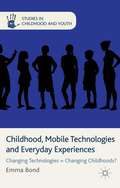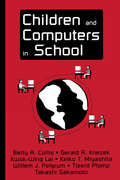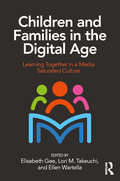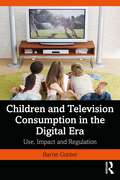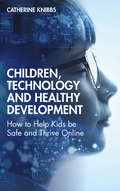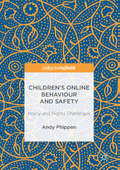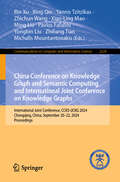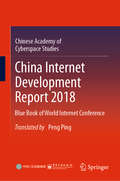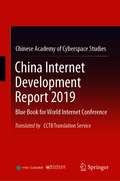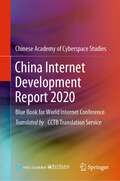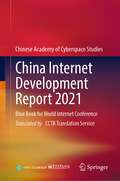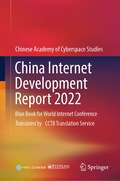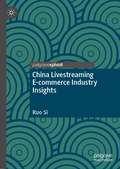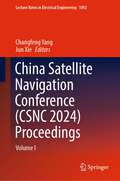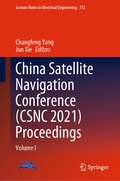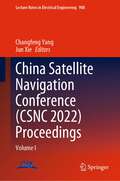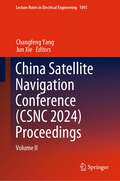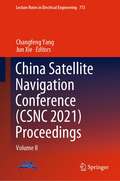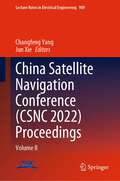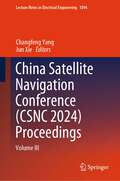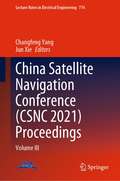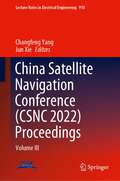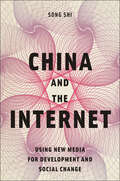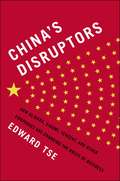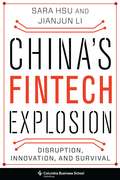- Table View
- List View
Childhood, Mobile Technologies and Everyday Experiences
by Emma BondThis timely volume offers an in-depth theoretical analysis of children's experiences growing up with mobile internet technologies. Drawing on up-to-date research, it explores the relationship between childhood as a social and cultural construction and the plethora of mobile internet technologies which have become ubiquitous in everyday life.
Children and Computers in School
by Kwok-Wing Lai Gerald A. Knezek Betty A. Collis Keiko T. Miyashita Willem J. PelgrumThis volume integrates research findings from three multinational studies conducted to examine the impact of children's use of computers in school. Conclusions are drawn from in-depth analyses of trends in more than 20 nations. Its seven authors from four nations were key researchers on these projects. Both a study and a product of the information age, this work is of prime importance to teachers, teacher educators, and school administrators. This work is unique in three important ways: * it presents data gathered in many regions of the world; * many of the authors are well-known and respected for their previous work in educational studies; and * the chapters are designed in such a way that the majority of the book is easily accessible to professionals such as classroom teachers who are interested primarily in findings, results, and outcomes rather than the methodology of the research.
Children and Families in the Digital Age: Learning Together in a Media Saturated Culture
by Ellen Wartella Elisabeth Gee Lori TakeuchiChildren and Families in the Digital Age offers a fresh, nuanced, and empirically-based perspective on how families are using digital media to enhance learning, routines, and relationships. This powerful edited collection contributes to a growing body of work suggesting the importance of understanding how the consequences of digital media use are shaped by family culture, values, practices, and the larger social and economic contexts of families’ lives. Chapters offer case studies, real-life examples, and analyses of large-scale national survey data, and provide insights into previously unexplored topics such as the role of siblings in shaping the home media ecology.
Children and Television Consumption in the Digital Era: Use, Impact and Regulation
by Barrie GunterChildren and Television Consumption in the Digital Era provides a comprehensive analysis of contemporary research on the developmental impact of children’s screen engagement in modern society. Barrie Gunter explores how the world of television has evolved to become almost unrecognisable from the broadcast landscapes present over the last years of the 20th century. This key text considers how screen-based entertainment has become increasingly interactive, and how children have become accustomed to creating their own television schedules through streamed services. It explores key topics including screen experiences and the manifestation of prosocial and antisocial behaviour, advertising and the development of consumerism, and the evidence of screen time on a child’s health and school performance. Gunter insightfully assesses television content that children are exposed to and its impact on cognitive and behavioural development. Featuring commentary on the challenges regulators face to keep up with rapidly developing screen technologies and suggestions on how parents can mediate their children’s screen behaviour, this text is an essential read for researchers and students taking courses in child development, family studies, broadcasting and communication.
Children, Technology and Healthy Development: How to help kids be safe and thrive online
by Catherine KnibbsHow can adults keep children safe and healthy online now and in the future? How can we thrive alongside technology? This highly accessible book unpacks the latest psychological research, attachment theory and neurobiology to offer parents and professionals insight into how technology impacts children’s development, and how to navigate our lives online. Cath Knibbs shares her extensive experience to reveal what we know about human behaviour in cyberspace, and particularly that of children using devices, consoles and social media platforms. She offers deeper understanding of how and why children engage online and shows parents and professionals how, rather than being overwhelmed by the dangers and pathologies of cyberspace, we can learn to support children in using technology healthily. She covers key topics including social media use and abuse, impact of screen time, issues around gaming, and extreme behaviours online. By the end of this book you will be able to understand your child better, and have an understanding of what is happening in their minds, brains and bodies in relation to the technological and digital world. Children, Technology and Healthy Development is for all parents, and professionals in psychology, education, social care and the police who are concerned with understanding how we support children in an online world. It will also be valuable reading for those in tech design interested in the impact of technology on the developing human.
Children’s Online Behaviour and Safety: Policy and Rights Challenges
by Andy PhippenThis book explores the use of technology in young people's social lives against a backdrop of "online safety measures" put in place by the UK government to ensure safe and risk free engagement with online services. The UK landscape is used as a case study to compare the grass roots of digital behaviours with attempts by policy makers to control access and prohibit "bad" behaviours. In conducting an analysis of current UK policy positions and media perspectives against ethnographic research in areas such as gaming and sexting, the book highlights the flaws in approaching the control of disruptive social behaviours using prohibitive approaches. It also highlights the gulf between the experiences of young people and the capabilities of the school system to deliver effective education around safe online behaviours. The author illustrates the complex relationship young people have with technology, as active engagers rather than passive consumers, and looks at the ways in which their needs for effective education and resilience are currently not being met. Furthermore, he demonstrates how, in an effort to make them safe, stakeholders are eroding children's fundamental rights. Children's Online Behaviour and Safety will be of interest to scholars, practitioners and students researching and practicing in education, sociology, children's law, children's digital rights and social policy.
China Conference on Knowledge Graph and Semantic Computing and International Joint Conference on Knowledge Graphs: International Joint Conference, CCKS-IJCKG 2024, Chongqing, China, September 20–22, 2024, Proceedings (Communications in Computer and Information Science #2229)
by Bin Xu Ming Liu Yannis Tzitzikas Bing Qin Yongbin Liu Zhiliang Tian Zhichun Wang Xian-Ling Mao Pavlos Fafalios Michalis MountantonakisThis book constitutes the joint refereed proceedings of the 18th China Conference on Knowledge Graph and Semantic Computing and the 13th International Joint Conference on Knowledge Graphs, CCKS-IJCKG 2024, held in Chongqing, China, during September 20–22, 2024. The 30 full papers and 11 other papers presented in this volume were carefully reviewed and selected from 168 submissions. They are organized in the following topical sections: Knowledge representation and reasoning; Knowledge graph construction and knowledge integration; Graph database and knowledge management; Machine learning on graphs; Knowledge retrieval and information retrieval; Knowledge graph and large language model applications; Knowledge graph open resources; Poster and demo; Evaluations.
China Internet Development Report 2018: Blue Book of World Internet Conference
by Chinese Academy of Cyberspace StudiesThis book is an important outcome of the Fifth World Internet Conference. It provides a comprehensive review of China’s Internet development, especially the new practice and achievement in 2018. And it offers a systematic account of China’s experience in Internet development and governance. This year, the book improves China’s Internet Development Index System, optimizes the algorithm model, and enhances data collection, to assess and reflect Internet development more comprehensively, objectively and scientifically.
China Internet Development Report 2019: Blue Book for World Internet Conference, Translated by CCTB Translation Service
by Chinese Academy of Cyberspace StudiesThis book systematically summarizes China Internet development over the past 25 years, highlighting its strong impact on China’s economy and society, and discussing the Chinese people’s transition from beneficiaries and participants to builders, contributors and joint maintainers of cyberspace development. It describes the development achievements, status and development and trends in China Internet in 2019, systematically summarizes the main lessons learned during development, and analyzes China’s strategic planning and policy actions. Further, it discusses topics such as development outcomes, future trends in information infrastructure, network information technology, digital economy, e-government, construction and management of network contents, cyberspace security, the legal construction of cyberspace, and international cyberspace governance. In addition, the book suggests improvements to the index system for China Internet development and offers an overall assessment of cyberspace security and informatization work throughout China in order to comprehensively and accurately demonstrate the level of China Internet development.
China Internet Development Report 2020: Blue Book for World Internet Conference
by Chinese Academy of Cyberspace StudiesThis book systematically summarizes the development process of China Internet in 2020, reveals the strong impact of Internet on China's economic development and social progress, and displays the course of the Chinese people's changes from beneficiary and participant to builder, contributor, and joint maintainer of cyberspace development and security during the Internet development; objectively reflects the development achievements, development status, and development trend of China Internet in 2020, systematically summarizes the main experience in the development of China Internet, and deeply analyzes China's strategic planning, policy actions, development results, practical level and future trend in information infrastructure, network information technology, digital economy, E-government, construction and management of network contents, network security, legal construction of cyberspace, international cyberspace governance, and other aspects; further improves the index system for the development of China Internet and makes an overall assessment of network security and informatization work in 31 provinces (autonomous regions and municipalities directly under the central government, excluding Hong Kong, Macao, and Taiwan) throughout China from 6 aspects, in the hope of reflecting the Internet development level throughout China and individual places comprehensively and accurately. With the important thoughts of General Secretary Xi Jinping on the national cyber development strategy as the main line running through the book, this book collects the latest research results in the domestic Internet field and utilizes the latest cases and authoritative data; featuring rich contents and highlights, this book helps the public readers to better comprehend the rich implications, spiritual essence, and practice requirements of the Internet governance concepts, thoughts, and opinions of General Secretary Xi Jinping and provides an important reference value for the employees in the Internet fields, such as government departments, Internet enterprises, scientific research institutions, colleges, and universities to fully understand and master the development of the China Internet.
China Internet Development Report 2021: Blue Book for World Internet Conference
by Publishing House of Electronics IndustryThis book objectively represents the achievements, status quo, and trends of China Internet development in 2021, systematically summarizes the main experience of China Internet development, and deeply analyzes the strategic planning, policies and measures, and development achievements, level, and trends in China in terms of eight aspects, i.e., information infrastructure, information technology, digital economy, e-government, cyber content, cybersecurity, cyberlaws, international cyberspace governance, and exchanges and cooperation. This book further optimizes the index system of China Internet development and comprehensively evaluates the work of cybersecurity and informatization in 31 provinces (autonomous regions, municipalities directly under the Central Government, excluding Hong Kong, Macao, and Taiwan) across the country from six dimensions, in order to mirror Internet development level in China and various regions in a comprehensive, accurate, and objective way.This book collects the latest research results in China Internet development and selects the latest cases and reliable data. With diverse subjects and detailed discussion, this book possesses great significance for these engaged in Internet field in governmental departments, Internet enterprises, scientific research institutions, and universities, who hope to fully understand China Internet development.
China Internet Development Report 2022: Blue Book for World Internet Conference
by Publishing House of Electronics IndustryThis book objectively presents the achievements, status quo, and trends of China's Internet development in 2022, systematically summarizes the major experiences of China's Internet development, and deeply analyses the strategic planning, policies and measures, and development achievements, level and trends in China in terms of eight aspects, i.e. information infrastructure, digital economy, e-government, digital society, cyber content, cybersecurity, cyber law, international cyberspace governance, and exchange and cooperation. This book further optimizes the index system of China's Internet development and comprehensively evaluates the work of cybersecurity and informatisation in 31 provinces (autonomous regions, municipalities directly under the Central Government, excluding Hong Kong, Macao and Taiwan) across the country from six dimensions, so as to reflect the Internet development level in China and various regions in a comprehensive, accurate and objective way. This book collects the latest research results on China's Internet development and selects the most recent cases and reliable data. With diverse topics and in-depth discussions, this book is of great significance to those involved in the Internet field in government departments, Internet enterprises, scientific research institutions, and universities who hope to fully understand China's Internet development.
China Livestreaming E-commerce Industry Insights
by Ruo SiThis book analyzes multiple aspects of the Chinese livestreaming e-commerce industry, including its development and evolution, macro environment, market landscape, platforms, streamer structure trends, influencers, production, and explosive marketing methods, MCN operations, risk assessment and policy management. It not only describes the highly developed state of the industry in China and how it has advanced further as a result of COVID lockdowns, but also focuses on the problems of livestreaming e-commerce and proposes solutions and development strategies.Investigating the development trends, the book also discusses how far livestreaming e-commerce can go during the wind-up period. In particular, based on the underlying logic of people, goods and fields, it assesses the streamer structure of universal participation, product selection, goods supply and price setting, exploring the scene marketing methods of pop-up conversion and the strategic layout of the operating platform. It objectively describes the current state of the Chinese livestreaming e-commerce market, and taking into account Chinese social, cultural, and economic characteristics, proposes solutions to problems in the livestreaming e-commerce industry. This unique book reflects on the Chinese livestreaming e-commerce, and offers insights to help readers understand the industry and the process of industrialization. It is intended for a wide range of readers, ranging from non-experts interested in livestreaming e-commerce, to professionals wanting an overview of the industry’s development.
China Satellite Navigation Conference: Volume I (Lecture Notes in Electrical Engineering #1092)
by Changfeng Yang Jun XieThis book presents selected research papers from China Satellite Navigation Conference (CSNC) 2024, held in Jinan, China, on 22–24 May 2024. These papers discuss the technologies and applications of the Global Navigation Satellite System (GNSS) and in particular the latest advances in the China BeiDou System (BDS). They are divided into 8 topics to match the corresponding sessions at CSNC 2024, which broadly covered key topics in GNSS. Readers learn about the BDS and keep abreast of the latest advances in GNSS technologies and applications.
China Satellite Navigation Conference: Volume I (Lecture Notes in Electrical Engineering #772)
by Changfeng Yang Jun XieChina Satellite Navigation Conference (CSNC 2021) Proceedings presents selected research papers from CSNC 2021 held during 22nd-25th May, 2021 in Nanchang, China. These papers discuss the technologies and applications of the Global Navigation Satellite System (GNSS), and the latest progress made in the China BeiDou System (BDS) especially. They are divided into 10 topics to match the corresponding sessions in CSNC2021 which broadly covered key topics in GNSS. Readers can learn about the BDS and keep abreast of the latest advances in GNSS techniques and applications.
China Satellite Navigation Conference: Volume I (Lecture Notes in Electrical Engineering #908)
by Changfeng Yang Jun XieChina Satellite Navigation Conference (CSNC 2022) Proceedings presents selected research papers from CSNC 2022 held during 25th-27th May, 2022 in Beijing, China. These papers discuss the technologies and applications of the Global Navigation Satellite System (GNSS), and the latest progress made in the China BeiDou System (BDS) especially. They are divided into 10 topics to match the corresponding sessions in CSNC2022 which broadly covered key topics in GNSS. Readers can learn about the BDS and keep abreast of the latest advances in GNSS techniques and applications.
China Satellite Navigation Conference: Volume II (Lecture Notes in Electrical Engineering #1093)
by Changfeng Yang Jun XieThis book presents selected research papers from China Satellite Navigation Conference (CSNC) 2024, held in Jinan, China, on 22–24 May 2024. These papers discuss the technologies and applications of the Global Navigation Satellite System (GNSS) and in particular the latest advances in the China BeiDou System (BDS). They are divided into 8 topics to match the corresponding sessions at CSNC 2024, which broadly covered key topics in GNSS. Readers learn about the BDS and keep abreast of the latest advances in GNSS technologies and applications.
China Satellite Navigation Conference: Volume II (Lecture Notes in Electrical Engineering #773)
by Changfeng Yang Jun XieChina Satellite Navigation Conference (CSNC 2021) Proceedings presents selected research papers from CSNC 2021 held during 22nd-25th May, 2021 in Nanchang, China. These papers discuss the technologies and applications of the Global Navigation Satellite System (GNSS), and the latest progress made in the China BeiDou System (BDS) especially. They are divided into 10 topics to match the corresponding sessions in CSNC2021 which broadly covered key topics in GNSS. Readers can learn about the BDS and keep abreast of the latest advances in GNSS techniques and applications.
China Satellite Navigation Conference: Volume II (Lecture Notes in Electrical Engineering #909)
by Changfeng Yang Jun XieChina Satellite Navigation Conference (CSNC 2022) Proceedings presents selected research papers from CSNC 2022 held during 22nd-25th May, 2022 in Beijing, China. These papers discuss the technologies and applications of the Global Navigation Satellite System (GNSS), and the latest progress made in the China BeiDou System (BDS) especially. They are divided into 10 topics to match the corresponding sessions in CSNC2022 which broadly covered key topics in GNSS. Readers can learn about the BDS and keep abreast of the latest advances in GNSS techniques and applications.
China Satellite Navigation Conference: Volume III (Lecture Notes in Electrical Engineering #1094)
by Changfeng Yang Jun XieThis book presents selected research papers from China Satellite Navigation Conference (CSNC) 2024, held in Jinan, China, on 22–24 May 2024. These papers discuss the technologies and applications of the Global Navigation Satellite System (GNSS) and in particular the latest advances in the China BeiDou System (BDS). They are divided into 8 topics to match the corresponding sessions at CSNC 2024, which broadly covered key topics in GNSS. Readers learn about the BDS and keep abreast of the latest advances in GNSS technologies and applications.
China Satellite Navigation Conference: Volume III (Lecture Notes in Electrical Engineering #774)
by Changfeng Yang Jun XieChina Satellite Navigation Conference (CSNC 2021) Proceedings presents selected research papers from CSNC 2021 held during 22nd-25th May, 2021 in Nanchang, China. These papers discuss the technologies and applications of the Global Navigation Satellite System (GNSS), and the latest progress made in the China BeiDou System (BDS) especially. They are divided into 10 topics to match the corresponding sessions in CSNC2021 which broadly covered key topics in GNSS. Readers can learn about the BDS and keep abreast of the latest advances in GNSS techniques and applications.
China Satellite Navigation Conference: Volume III (Lecture Notes in Electrical Engineering #910)
by Changfeng Yang Jun XieChina Satellite Navigation Conference (CSNC 2022) Proceedings presents selected research papers from CSNC 2022 held during 25th-27th May, 2022 in Beijing, China. These papers discuss the technologies and applications of the Global Navigation Satellite System (GNSS), and the latest progress made in the China BeiDou System (BDS) especially. They are divided into 10 topics to match the corresponding sessions in CSNC2022 which broadly covered key topics in GNSS. Readers can learn about the BDS and keep abreast of the latest advances in GNSS techniques and applications.
China and the Internet: Using New Media for Development and Social Change
by Song ShiTwo oversimplified narratives have long dominated news reports and academic studies of China’s Internet: one lauding its potentials to boost commerce, the other bemoaning state control and measures against the forces of political transformations. This bifurcation obscures the complexity of the dynamic forces operating on the Chinese Internet and the diversity of Internet-related phenomena. China and the Internet analyzes how Chinese activists, NGOs, and government offices have used the Internet to fight rural malnutrition, the digital divide, the COVID-19 pandemic, and other urgent problems affecting millions of people. It presents five theoretically informed case studies of how new media have been used in interventions for development and social change, including how activists battled against COVID-19. In addition, this book applies a Communication for Development approach to examine the use and impact of China’s Internet. Although it is widely used internationally in Internet studies, Communication for Development has not been rigorously applied in studies of China’s Internet. This approach offers a new perspective to examine the Internet and related phenomena in Chinese society.
China's Disruptors: How Alibaba, Xiaomi, Tencent, and Other Companies are Changing the Rules of Business
by Edward TseIn September 2014, Chinese e-commerce giant Alibaba raised $25 billion in the world's biggest-ever initial public offering. Since then, millions of investors and managers worldwide have pondered a fundamental question: What's really going on with the new wave of China's disruptors? Alibaba wasn't an outlier--it's one of a rising tide of thriving Chinese companies, mostly but not exclusively in the technology sector. Overnight, its founder, Jack Ma, appeared on the same magazine covers as American entrepreneurial icons like Mark Zuckerberg. Ma was quickly followed by the founders of other previously little-known companies, such as Baidu, Tencent, and Xiaomi.Over the past two decades, an unprecedented burst of entrepreneurialism has transformed China's economy from a closed, impoverished, state-run system into a major power in global business. As products in China become more and more sophisticated, and as its companies embrace domestically developed technology, we will increasingly see Chinese goods setting global standards. Meanwhile, companies in the rest of the world wonder how they can access the fast-rising incomes of China's 1.3 billion consumers.Now Edward Tse, a leading global strategy consultant, reveals how China got to this point, and what the country's rise means for the United States and the rest of the world. Tse has spent more than twenty years working with senior Chinese executives, learning firsthand how China's most powerful companies operate. He's an expert on how private firms are thriving in what is still, officially, a communist country. His book draws on exclusive interviews and case studies to explore questions such as*What drives China's entrepreneurs? Personal fame and fortune--or a quest for national pride and communal achievement?*How do these companies grow so quickly? In 2005, Lenovo sold just one category of products (personal computers) in one market, China. Today, not only is it the world's largest PC seller; it is also the world's third-largest smartphone seller.*How does Chinese culture shape the strategies and tactics of these business leaders? Can outsiders copy what the Chinese are doing?*Can capitalists really thrive within a communist system? How does Tencent's Pony Ma serve as a member of China's parliament while running a company that dominates online games and messaging?*What impact will China have on the rest of the world as its private companies enter new markets, acquire foreign businesses, and threaten established firms in countless industries?As Tse concludes: "I believe that as a consequence of the opening driven by China's entrepreneurs, the push to invest in science, research, and development, and the new freedoms that people are enjoying across the country, China has embarked on a renaissance that could rival its greatest era in history--the Tang dynasty. These entrepreneurs are the front line in China's intense hunger for success. They will have an even more remarkable impact on the global economy in the future, through the rest of this decade and beyond."From the Hardcover edition.
China's Fintech Explosion: Disruption, Innovation, and Survival
by Jianjun Li Sara HsuFinancial technology—or fintech—is gaining in popularity globally as a way of making financial services more efficient and accessible. In rapidly developing China, fintech is taking off, catering to markets that state-owned banks and an undersized financial sector do not serve amid a backdrop of growing consumption and a large, tech-savvy millennial generation. It is becoming increasingly likely that some of China’s fintech firms will change the way the world does business.In China’s Fintech Explosion, Sara Hsu and Jianjun Li explore the transformative potential of China’s financial-technology industry, describing the risks and rewards for participants as well as the impact on consumers. They cover fintech’s many subsectors, such as digital payment systems, peer-to-peer lending and crowdfunding, credit card issuance, internet banks, blockchain finance and virtual currencies, and online insurance. The book highlights the disruption of traditional banking as well as the risks of fintech and regulatory technology. Hsu and Li describe major companies including Alipay and Tencent, developer of WeChat Pay and a wealth-management business, and other leading fintech firms such as Creditease, Zhong An Insurance, and JD Finance. Offering expert analysis of market potential, risks, and competition, as well as case studies of firms and consumer behavior, China’s Fintech Explosion is a must-read for anyone interested in one of the world’s breakout sectors.
